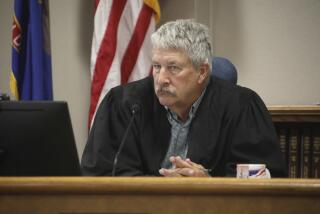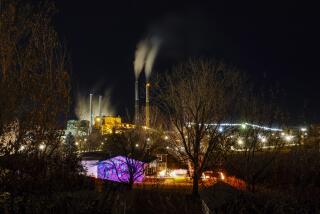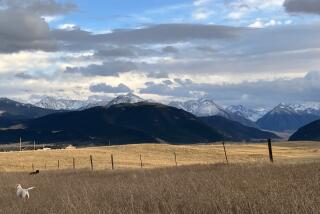A School Closes and Rural Town Fears It’s Next
BUTTE, N.D. — Everyone here knew this was coming. The harbingers have appeared year after year.
Butte once had seven churches, then six, then five, four, three, now two. There used to be two banks, now one, which stays open just half a day. The laundermat requires just one washer and one dryer these days.
On Saturday, with the soil too wet to till and two separate layers of clouds sliding in different directions across the Plains, a crowd larger than the town’s entire population of 126 or so gathered at Butte Public School.
Dressed in their Sunday best, they came to bid farewell to Heidi Schatz and Elizabeth Haugen--co-valedictorians, co-homecoming queens, and the only two seniors.
And they came to close down the school.
“We still got some older folks,” said Wayne Schatz, Heidi’s uncle. “We just run out of kids.”
After decades of decline that began with the Industrial Revolution, the population in rural America has increased markedly in recent years, researchers recently found, gaining about 4 million residents between 1990 and mid-1998.
But it didn’t grow everywhere. Across the Great Plains especially, from the Canadian border south to the Texas Panhandle, small towns have continued to wither and, sometimes, vanish.
“Natural decrease,” demographers call it, when the number of people dying or leaving outpaces the number of births and newcomers.
Here in Butte, that’s how it’s worked for more than a generation: The kids grow up working the wheat and durum fields, move to Minot or Bismarck and stay there. The old-timers remain and eventually die. The farm families have two or three kids instead of six or eight.
Here in McLean County, 193 more people were buried than were born in the past seven years. And the state is home to eight of the 10 fastest-shrinking counties in the nation.
There’s a saying in rural North Dakota: If there’s a bar, there’s a town. And Wayne Schatz’s place, Hunter’s Lodge, is doing fine.
But all around, from Mercer in the south to Bergen in the north to Kief in the west, the towns that have closed their schools are hurting, dying, slowly.
“The school,” said Heidi Schatz shortly before delivering her tearful valedictory speech, “is the town.”
It’s where townspeople met, where the electric co-op held its meetings, where piano lessons were taught. Two teachers lived in apartments on the upper floor. It’s where all the funerals were held.
“The churches just aren’t big enough,” said Ruby Evanenko, 78, who was named school superintendent during World War II because all the eligible men had gone to war. “And in a small town, you know, everybody goes to a funeral.”
Built in 1906, the same year the town was founded, Butte Public School has always been the focal point of the community, its mirror, and a microcosm of what is taking place in communities across the Plains.
When Evanenko was in charge, the school boasted a roster of more than 200 students and 30 or so graduates each year. When Heidi Schatz’s mom, Dodie, was homecoming queen in 1972, and Elizabeth Haugen’s dad, Jerry, was homecoming king, there were 12 graduates.
This past year, there were no kindergartners, no first- or second-graders, and only 34 students overall. Levi Heil, 9, was the only fourth-grader. He’s never had a classmate in his own grade and, as far as he can recall, never had to raise his hand to answer a question.
In 1947, North Dakota had 2,200 school districts, in 1961 1,010. Today there are 231, with the 15 largest educating 60% of the state’s students. The smallest districts will lose another 40% of their students over the next decade.
Education officials across the Midwest are grappling with the problem of shrinking districts. Iowa, Texas and Minnesota all promote regional schools, pooling resources in a single, larger facility that can draw students from as far away as 60 miles.
In Wyoming, lawmakers have twice cut the number of school districts. In South Dakota, high schools are shuttered if enrollment drops below a prescribed level.
In 1989, North Dakota began offering money to small school districts willing to close up shop and send their students elsewhere. But there were few volunteers.
“Some people are vehemently opposed,” said Tom Decker of the North Dakota Department of Public Instruction, who spends much of his time trying to convince folks that consolidation can be both educationally and financially beneficial. “The wisdom on the street is that if our school closes, our community will die. But the closure of a school . . . is a symptom, not a cause. And there’s no indication that the cause, declining rural populations, will turn around.”
The children of Butte will be all right. They’ll spend as much as two hours on the bus each day, heading to and from schools in Anamoose, Drake, Velva or Turtle Lake.
It’s the town everyone’s worried about.
Nearly all the rural communities that have grown in recent years boast “natural amenities” such as lakes, mountains, warm weather for retirees. Butte has a few fishable small lakes known as “prairie potholes” nearby, but mostly it has boasted a good volunteer fire department, tasty Rocky Mountain oysters at Hunter’s Lodge, and a school with a 100% graduation rate.
People now are hoping, a few praying, that somebody will buy the school building, start a business, lure back the young mechanic who found his fortune in Grand Forks, the young accountant in Fargo. One businessman with a sense of prairie adventure could prove all the demographers wrong.
“Forty-three thousand square feet of handicapped-accessible school complex,” the ad reads on an Internet real estate site. “Property includes classrooms, offices, a safe, auditorium, bus garage, two wells, the works.”
The boxes of small rodent bones and big magnets from the science lab, the art supplies, the desks and chairs and filing cabinets--those aren’t included. They’ll be auctioned off in June.
“If somebody doesn’t buy, the town dies,” said school board Chairman Roger Lakoduk. He shook his head. “It probably will anyhow.”
After the ceremony, the seniors--both 4.0 students--stood outside the school, grinning and having their pictures taken. They adjusted their blue mortarboards and told of their plans.
Both are off to college in Minot, 45 miles distant. Both love this town and would like to move back some day. But who knows.


